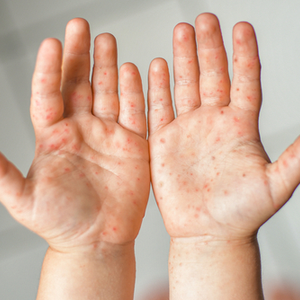Quick Links

Hand, foot, and mouth disease is a common viral infection in children. This infection is characterized by red blisters or sores in the mouth, throat, and on the body. Although this disease can affect people of all ages, children under the age of 5 are most at risk since it is spread through contact like schools and childcare centers. Hand, Foot, and Mouth disease is an extremely contagious viral infection. It is easily spread through unwashed hands, saliva, mucus, or fluid from the blisters. Unfortunately, there is no cure for Hand, Foot, and Mouth disease or vaccine to prevent it. However, most symptoms clear up within a week and they fully recover.
Contact our team at Trillium Creek Dermatology & Surgery Center for help with Hand Foot and Mouth Disease in toddlers, babies, and infants.
What Causes Hand, Foot, and Mouth Disease?
Hand, Foot, and Mouth disease are caused by a strain of coxsackievirus. This virus is part of a group of viruses called enteroviruses. Other types of viruses in this group can also cause Hand, Foot, and Mouth disease. The virus can easily spread through contact with people. Adults and children can contract this disease through:
- Fluid from blisters
- Saliva
- Feces
- Respiratory droplets from coughing or sneezing
- Unwashed hands
- Contact with surfaces that have traces of the virus
It is very important to continuously wash your hands when in public areas or around people with this disease.
Symptoms of Hand, Foot, and Mouth Disease?
Hand, foot, and mouth disease causes red blisters with a small bubble of fluid. Often these blisters peel, leaving an ulcer. A rash may appear on the soles of the feet and palms of the hands. Occasionally, children may also get a pink rash on the buttocks or thighs. It can be difficult sometimes to tell if a young child has HFM. Some other symptoms they may experience are:
- Fever
- Muscle aches
- Excessive swelling
- Irritable
Treatments for Hand, Foot, and Mouth Disease?
Cold foods like ice cream, smoothies, and popsicles help to numb the mouth and throat and relieve the pain from the blisters. You can also give your children acetaminophen or ibuprofen to help with aches. We can also prescribe topical ointments.



